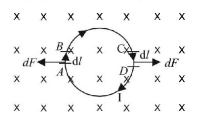Question
A conducting circular loop of radius $$r$$ carries a constant current $$i.$$ It is placed in a uniform magnetic field $${{\vec B}_0}$$ such that $${{\vec B}_0}$$ is perpendicular to the plane of the loop. The magnetic force acting on the loop is
A.
$$ir\,{B_0}$$
B.
$$2\pi \,ir\,{B_0}$$
C.
zero
D.
$$\pi \,ir\,{B_0}$$
Answer :
zero
Solution :
The magnetic field is perpendicular to the plane of the paper. Let us consider two diametrically opposite elements. By Fleming's left hand rule, on element $$AB$$ the direction of force will be leftwards and the magnitude will be
$$dF = I\left( {d\ell } \right)B\sin {90^ \circ } = I\left( {d\ell } \right)B$$

On element $$CD,$$ the direction of force will be towards right on the plane of the paper and the magnitude will be
$$dF = I\left( {d\ell } \right)B.$$
These two forces will cancel out.
NOTE : Similarly, all forces acting on the diametrically opposite elements will cancel out in pair. The net force acting on the loop will be zero.
The magnetic field is perpendicular to the plane of the paper. Let us consider two diametrically opposite elements. By Fleming's left hand rule, on element $$AB$$ the direction of force will be leftwards and the magnitude will be
$$dF = I\left( {d\ell } \right)B\sin {90^ \circ } = I\left( {d\ell } \right)B$$

On element $$CD,$$ the direction of force will be towards right on the plane of the paper and the magnitude will be
$$dF = I\left( {d\ell } \right)B.$$
These two forces will cancel out.
NOTE : Similarly, all forces acting on the diametrically opposite elements will cancel out in pair. The net force acting on the loop will be zero.